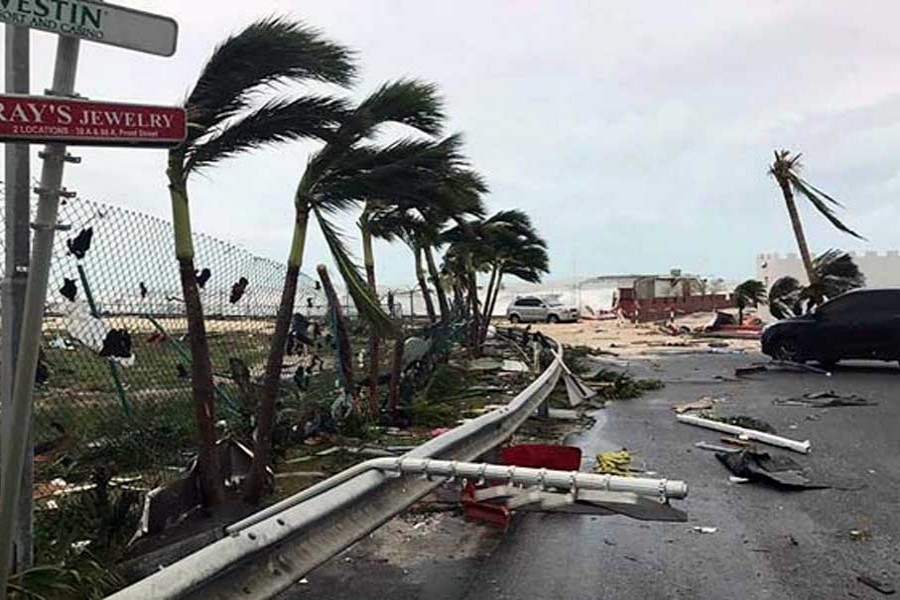As I left Manila, tropical storm Isang passed the Batanes area in northern Philippines. When I flew to Guangzhou in southern China, the low-pressure area morphed into a tropical depression southeast to Taiwan and then into a typhoon in the South China Sea. On August 23, Hato's eye was directly over Hong Kong as rapid intensification turned it into a category 3-equivalent typhoon. Days later, Hato had left behind 26 people killed, and damages amounting to $1.9 billion in mainland China.
Almost at the same time, Harvey was still classified as a tropical storm before entering the Caribbean, until it nearly dissipated. Thanks to warm sea surface temperatures and low windshear, it strengthened rapidly into a category 4 hurricane within 24 hours before hitting the shoreline of Texas on August 26.
After biblical rain and historical flooding, 30,000 displaced people and more than 50 confirmed deaths, recovery is likely to take "many years." Exposed stock with damage to floods is calculated at $267 billion. That's more than the effect of the 2011 T?hoku earthquake and tsunami, the 2008 Sichuan earthquake, or the 2005 Hurricane Katrina and 2012 Sandy combined.
After Hato in China and Harvey in Texas, Irma has strengthened into the strongest Hurricane on record in the Caribbean and the Gulf of Mexico. After Puerto Rico, it will cast a shadow over Florida. The threat of natural disasters has substantial economic implications. In Texas alone, state and local debt exceeds $370 billion (25 per cent of state GDP or gross domestic product). As Puerto Rico has prepared for the "catastrophic system," its fiscal crisis is about to play out in court, with some $125 billion in debt and pension obligations (nearly 130 per cent of GDP, about the same as in Italy).
In all these cases, extreme weather proved far more destructive than initially anticipated, navigated across several country boundaries, and left behind huge economic devastation that typically deepened income polarisation. In each case, too, scientists see less the effect of a natural disaster and more the forces of human-induced climate change.
Ironically, as extreme weather phenomena are intensifying, international efforts to contain collateral damage may be failing.
TRUMP'S PLANNED EXIT FROM PARIS ACCORD: During his campaign, President Trump pledged to withdraw America from the Paris Climate Accord, which seeks to reduce the effects of climate change by maintaining global temperatures "well below 2°C above pre-industrial levels." The pact was negotiated by almost 200 parties and adopted by consensus in December 2015.
During his campaign, Trump called the pact a "bad deal" for the US and framed withdrawal as a key piece of the "America First" platform.
The White House initiated the exit path from the climate agreement already in March, when Trump signed an executive order to begin the formal process of repealing President Obama's unilateral climate agenda, including ending carbon rules for power plants which is seen as the key to achieve the Paris goal.
On June 01, Trump announced America would withdraw from the Paris Climate Agreement. Yet, legal questions linger as to how the Trump White House can execute the withdrawal and what role the US can play in future international climate meetings.
If Trump ultimately will implement the withdrawal, the global economy will be held hostage by the greatest polluting nation - as measured on a per capita basis - and, more precisely, by a conservative minority of about a fifth of American voters and wealthy financiers whose continued fortunes are predicated on worsening global climate change.
COLLATERAL DAMAGE IN CHINA AND ASIA: While Trump has expressed scepticism about the scientific basis of climate change, he has portrayed the concern over extreme weather as an obstacle to US competitiveness. These misguided views seem to go back to in November 2012, when he famously tweeted that "the concept of global warming was created by and for the Chinese in order to make US manufacturing non-competitive."
Thanks to its great growth performance, China has soared into the world's second-largest economy while overtaking the US and the EU as the world's largest emitter, with CO2 emissions from fossil fuels tripling over the past 30 years. Nevertheless, China is estimated to account for "only" 10-12 per cent of total greenhouse gases in the atmosphere. That figure that has remained fairly steady over the industrial period.
Since climate change is not just cumulative but accumulative, current greenhouse gases and aerosols have been collected in the atmosphere over the entire industrial era. By this measure, the UK remains the largest single cause of climate change, followed by the US and Germany. China is the world's greatest polluter on an aggregate basis but not on a per capita basis.
If US climate exit will materialise, global climate risks will intensify dramatically. As far as Trump is concerned, that's not America's problem. In a tragic sense, he is right. While the bulk of global climate risks can be attributed to today's prosperous advanced economies, it is the relatively poor emerging and developing economies that those risks will primarily penalise in the future, especially in Asia.
According to Global Climate Risk Index, most of the 10 countries affected in the past two decades feature emerging economies in Asia (Myanmar, Philippines, Bangladesh, Pakistan, Vietnam and Thailand).
Timing matters. Under the agreement, the earliest effective date of the US withdrawal is November 2020 - the last month of the Trump presidency, in the absence of an impeachment.
Dr Dan Steinbock is the founder of Difference Group and has served as research director at the India, China and America Institute (USA) and visiting fellow at the Shanghai Institutes for International Studies (China) and the EU Center (Singapore).


